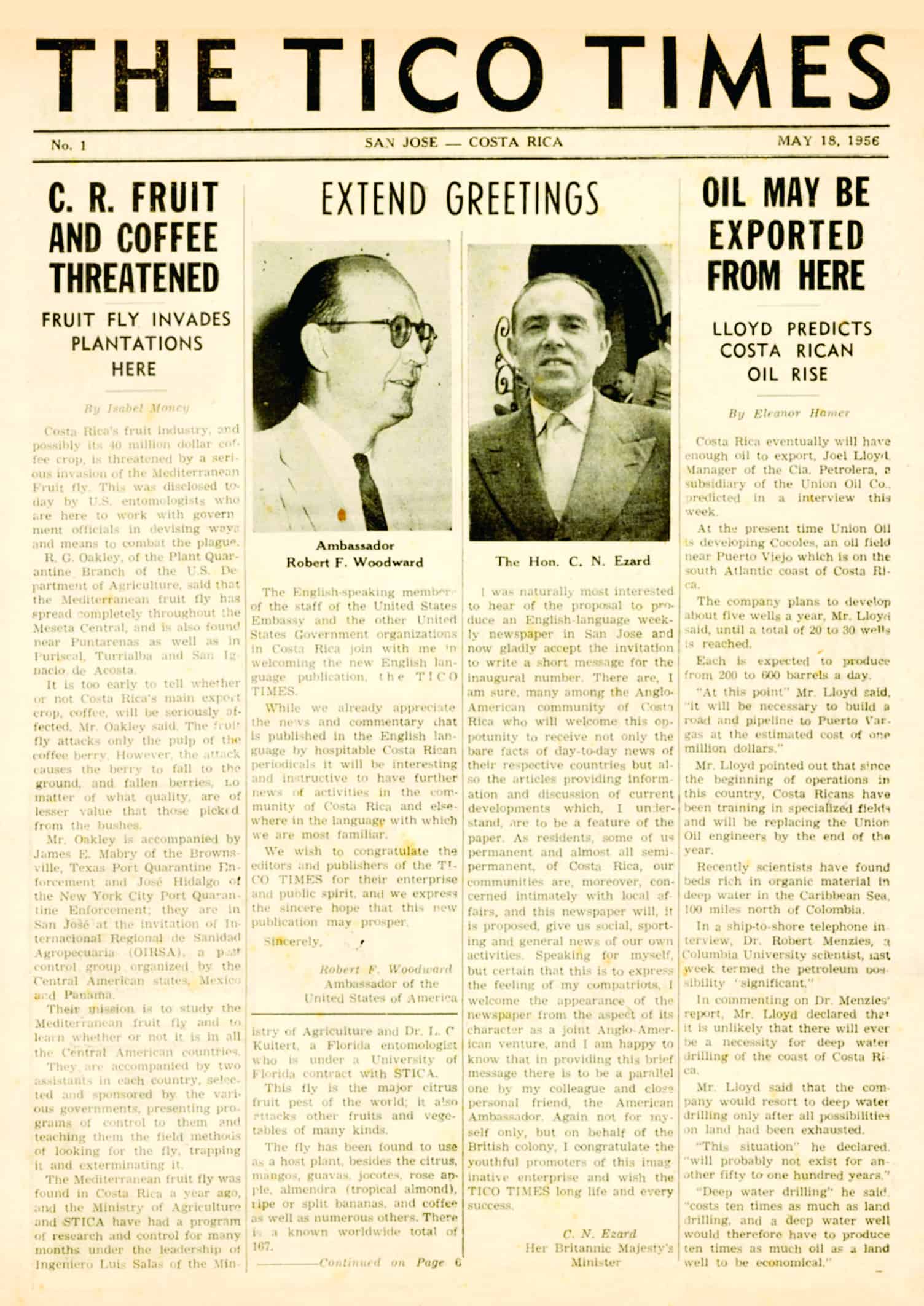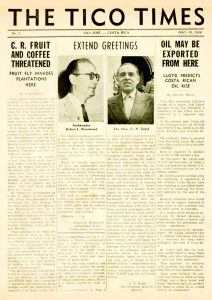
Of all the stories The Tico Times has reported in its six decades of publication, one of the most remarkable is the story of the paper itself. Its 60th birthday provides a chance to look back on the unlikely tale of a student project that went on to become an intrepid public watchdog, a strong independent voice and defender of press freedom, and a builder of bridges between Costa Rica and the international community.
The paper was first created thanks to one of the serendipitous alignments of interest and expertise that seem to happen so often in Costa Rica: a group of Lincoln School seniors asked Elisabeth (Betty) Dyer, a veteran journalist from the United States who was a full-time mother in Costa Rica, to teach them about journalism. Her response? She urged them to learn by doing, and the result was the first edition of the paper, published on May 18, 1956 with a newsstand price of ¢1.

The paper met a need among the growing expatriate community in the country, and grew quickly into a beloved weekly. For founder Betty Dyer and her husband Richard, who would become the paper’s publisher, it was an opportunity to return to what they loved most. Betty had been a trailblazer in New York journalism as the “first woman rewrite man” and p.m. editor for the New York Post, covering traditionally male beats including crime, labor and politics. Richard’s journalism career had included stints as the news editor of the Oakland Post-Enquirer in California and the AP assistant bureau chief in Río de Janeiro.
Betty left her career behind after she married Richard and joined him in Río, where he served as bureau chief for the International News Service and King Features syndicate. When Richard got a job as the United Fruit Company’s public relations director for Central America in 1951, they moved to Costa Rica with their young daughter, Dery. (Dery would grow up to become the editor and publisher of The Tico Times.)

Over the years, the paper they created attained worldwide readership for its independence in a region marked by turmoil and weak press. Reporters broke stories on secret runways used by the Contras, rampant shark finning in Costa Rican waters and the rise of the Sandinista revolution in Nicaragua. It became a training ground for generations of young journalists.
The Tico Times racked up a series of firsts. It was the first newspaper in Costa Rica (along with Eco Católico) to be printed on offset, the first to run color on its front page, the first to do investigative reporting and the first to cover the environment as a regular beat.
The Tico Times and La Nación were the country’s first newspapers to have an online edition, and The Tico Times was the first and only paper in the country to raise funds for animal welfare or hold a public blood drive. (“People would come in the office to place a classified ad and we’d grab ‘em and say: ‘Your money or your blood,” remembered Dery Dyer. “We had a great time, served cookies and beer, had people fainting all over the place. But we got a lot of donors.”)
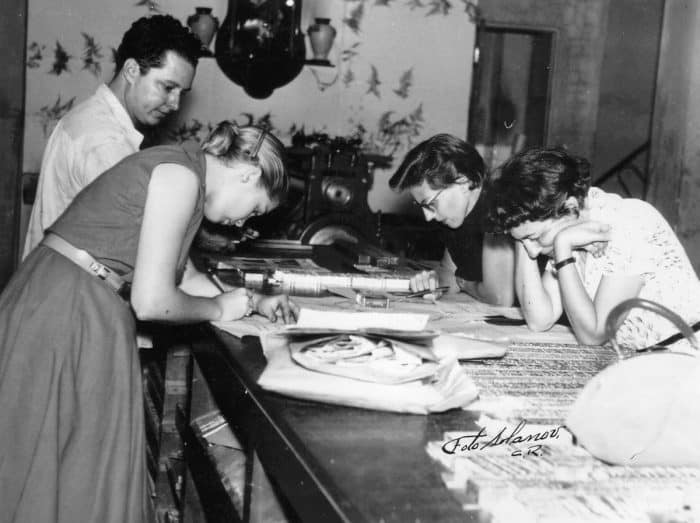
Its records included some quirkier feats as well: The Tico Times was the first newspaper in Costa Rica, and probably in the world, to run a “subliminal photo” on its front page, and it was likely the only newspaper anywhere to refrain from publishing anything about the O.J. Simpson case.
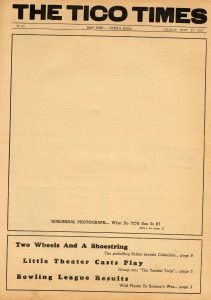
It would be impossible in this brief format to do justice to the changes that Costa Rica experienced, and The Tico Times chronicled, in the past six decades (although our 50th Anniversary Special Edition, published in 2006, went a long way toward that goal – view it below). The paper, in its first year, covered the birth of the millionth Costa Rican; and in 2000, it covered the arrival of the millionth foreign tourist.
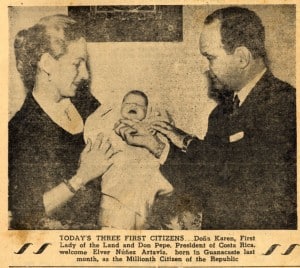

Those two milestones alone show the dizzying growth the country experienced, and the problems that came along with it, including the controversies of balancing between tourism needs and environmental protections, and the struggle to protect traditions in the face of increasing international influence.
The Tico Times covered all of these issues, year after year.
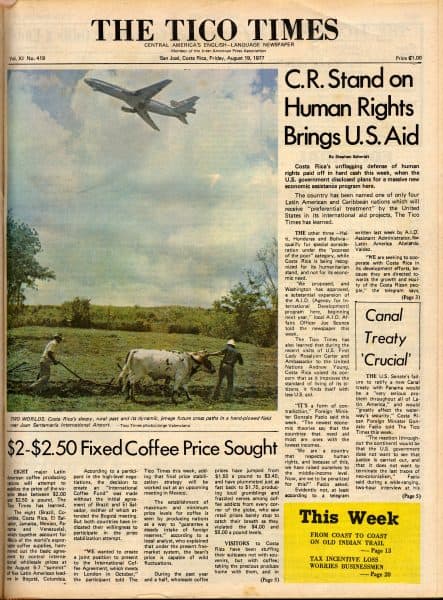
In the 1980s, when Central America’s armed conflicts cast the region into chaos, the relative stability of Costa Rica made San José, and often The Tico Times, a home base for some of international journalism’s leading lights. The paper covered all aspects of the conflicts, peace negotiations and the eventual peace accords that earned a Nobel Peace Prize for President Oscar Arias in 1987. During the years of unrest, on May 30, 1984, The Tico Times family suffered a tragic loss when reporter Linda Frazier died from the injuries she sustained in an explosion at a press conference in La Penca, the jungle encampment of Nicaraguan rebel leader Eden Pastora. The message “In Memoriam – Linda Frazier” appeared in The Tico Times masthead each week for as long as the paper was printed, and continues to appear on our About Us page today.
Like the country it calls home, The Tico Times has often had an impact that far outpaces its small size. One example was its struggle for freedom of expression against a provision of the country’s journalists guild that required reporters to be licensed by that organization in order to be published in Costa Rica. This ban hit The Tico Times hard, since the paper relied on international talent and, since its early days when other English-language news was hard to come by in the country, had served its readers by reprinting news from around the globe.
The Tico Times fought the prohibition for many years, eventually achieved its repeal and, in 1995, won the Inter-American Press Association (IAPA) Grand Prize for Press Freedom for its efforts. This award joined others The Tico Times has won throughout its history, including the IAPA Pedro G. Beltrán Award for distinguished service to the community (1981); a Special Citation from Columbia University’s Maria Moors Cabot Awards (1985); the National Conservation Prize (1990); the Salvation Army’s Others Award, for launching and supporting the Angel Tree program in Costa Rica (1998); the National Tourism Chamber Media Award (1998); and the Alberto Martén Chavarría Award for best journalistic work in the area of social responsibility, American-Costa Rican Chamber of Commerce Social Responsibility in Action Awards (2015).
Through it all, however, the paper sought to retain its home-grown feel in keeping with its grassroots origins.
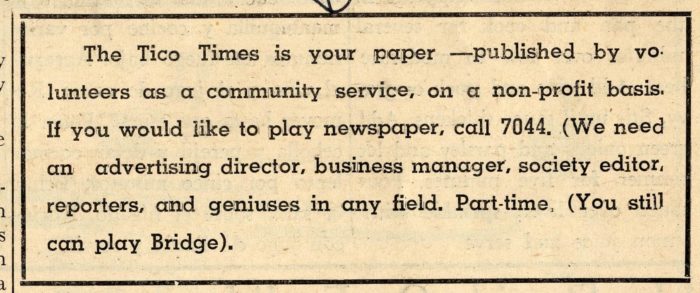
The paper celebrated its 50th anniversary in 2006 — but some of its greatest challenges were just around the corner. In the paper’s heyday from 2005-2007, it reached a size of 60 printed pages, thanks largely to a real estate boom that generated most of The Tico Times’ advertisements. That boom, along with the housing crisis in the United States, turned out to be a bubble, and when it burst, the paper faced a double dilemma of advertising flight and the onset of the digital age in Costa Rica.
Like most print media around the world, the paper struggled to make ends meet, and on September 28, 2012, its final print edition hit newsstands. The paper’s home of many years, near the Judicial System in San José, was eventually sold, and parked cars now line the lot where writers, editors, sales and circulation staff toiled for so many years.
But that wasn’t the end for The Tico Times. In a show of grit, creativity and commitment to the organization’s ideals, various staff members chose to stay on board on a volunteer basis or with drastically reduced salaries to keep the paper going, and an Indiegogo campaign was launched to raise funds.
Readers donated more than $8,000 in 30 days to allow the paper to cover basic operating costs as it made the transition to an online media outlet, eventually allowing the organization to find its new home at wordpress-257819-2837440.cloudwaysapps.com and its new offices in Barrio Amón, under the leadership of publisher Jonathan Harris.
So the past decade included a difficult “last” for the paper, but brought a wave of firsts and new developments for an organization used to paving the way. These included a new logo that debuted in 2014; the first book from our Publications Group, “The Green Season,” by former staff writer Robert Isenberg, published in 2015; and the first event from our Events Group, “News and Brews,” held last Saturday in San José.
Through the changes, of course, The Tico Times has continued covering the news shaping Costa Rica, in creative ways made possible by the new digital format. Editorial highlights from the last decade ranged from continuing coverage of politics, trade, environmental issues and international relations, a photo essay to celebrate the country’s astonishing performance at the 2014 World Cup, and the tale of a beloved crocodile that continues to be one of our most-read stories nearly four years after his death.

Writers have been able to stretch out their legs in the luxury of unlimited online space through longform stories on everything from cycling across the country, to a visiting athlete who survived against the odds, to the extraordinarily life of a previous First Lady, to the crimes of a serial killer that have been largely ignored by other media.
What’s next for The Tico Times? As Dery Dyer points out in her special letter in honor of this anniversary, there’s no telling what the future holds, but this is an organization that has persevered through tough times and embraced the future. In the end, what can be said to top the message that accompanied that first edition 60 years ago today? “This is THE TICO TIMES. It’s out. We hope it will come out again next week… and we hope that you find THE TICO TIMES ‘good reading.’”

